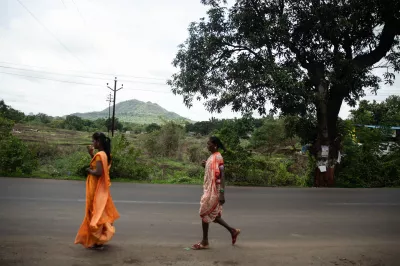Ride-Hailing Drivers in Indonesia Discuss Livelihoods, COVID-19
If you’ve been to Jakarta recently, you will no doubt have spent more time than you wished stuck in traffic. Another certainty is that you spotted a tide of green-clad motorcycle drivers with passengers streaming by your window. These drivers belong to two ride-hailing services, domestic Go-Jek and foreign-owned Grab. Both services offer people a means of weaving around vehicles and getting where they need to be without sitting in bumper-to-bumper traffic.

The drivers who work for these ride-hailing companies are among the tens of millions of Indonesians who now sell goods and services on digital platforms. For all intents and purposes, these companies are like Uber for motorbike ride-hailing in Indonesia. Both platforms claim to have 2 million drivers, and their success has allowed them to branch out into the delivery of food and other goods and services. Customers pay for goods and services using affiliated digital wallets (GoPay and Ovo) and receive goods at brick-and-mortar stores within each company’s merchant partner network. The process of becoming a driver involves signing up for a bank account and an e-wallet. In some cases, signing up is a new driver’s first interaction with a formal financial services.
All this raises the question: Is digital platform work a vehicle for financial deepening? Has ride-hailing enabled drivers to take up a broader range of financial services and extract more value from them?
In March 2020, CGAP conducted in-depth interviews with six ride-hailing drivers to better understand their financial lives. We rode with drivers around Jakarta and spoke with them about their relationships with ride-hailing companies, whether and how these relationships led them to engage with digital financial services and how the COVID-19 pandemic has affected their work. Here’s what we discovered during these conversations.
- Ride hailing is the sole source of income for all six drivers.
- All the drivers appreciate their flexible work hours. The flexibility allows them to balance work and personal commitments like taking children to school. One driver even commented that the flexibility made him feel more like a partner than an employee.
- All the drivers say they are interacting deeply with financial services as a result of their work. Most already had a bank account before they started working for Grab and Go-Jek, but they are using their accounts more often now to rebalance the e-wallets associated with their ride-hailing accounts. One driver reported appreciating the transparency of electronic transactions and lack of bargaining involved. All the drivers had borrowed from their platform to acquire helmets. Some also had borrowed to purchase a motorcycle and smartphone.
- None of the drivers uses agents to rebalance e-float. They’ve become adept at using their smartphones to manage liquidity between their bank accounts and e-wallets.
- COVID-19 is severely affecting the amount of work available to the drivers. They report their incomes dropped by half to two-thirds.
- Platforms have enabled drivers to adapt to the crisis by transitioning to food delivery. Ride-hailing companies have become digital platforms that aggregate many services, making it possible for drivers to pivot to services that have seen demand hold steady or grow during the pandemic. Go-Jek has distributed staple goods to drivers over 60 years old and vouchers for staples to younger drivers in parallel to relaxing vehicle loan repayment requirements. Drivers who fall ill with COVID-19 also can receive financial aid from Go-Jek.
Our interviews suggest that platform work such as ride-hailing can improve resilience by stabilizing people’s income and creating valued use cases, not only for payments but also for responsible credit and savings. CGAP’s interviews in Kenya with ride-hailing drivers and other gig workers highlight the potential demand for such use cases and the importance of linking loan repayment schedules to gig workers' often volatile incomes. The workforce of ride-hailing drivers in Indonesia is diverse along gender lines, educational attainment and role within the household to name a few demographics. Drivers also are exposed to different social norms that restrict what they can do. Distinguishing among the individual characteristics that are associated with positive and negative outcomes will help us understand how digital platform work may lead to financial inclusion and improved well-being.
Large platforms engage in (or can easily pivot to) essential services such as food delivery like Grab and Go-Jek will surely survive the COVID-19 crisis. Their ability to lower their cost structures in times of crisis by owning so few fixed assets allows them to weather the storm and potentially create more jobs. The impact of the crisis on workers is more severe. Even Grab and Go-Jek drivers who have managed to pivot to food delivery services have experienced significant declines in their income, along with an increased risk of sickness. The longer-term impact of platform work on the financial lives of poor people and their livelihoods is an open question. The power imbalance between a driver and platform with growing market influence is stark, and if the Grab takeover of Uber in Indonesia taught us anything, it’s that drivers can get squeezed when businesses have so much power.
We will continue our efforts to learn more, so stay tuned. You can find background details of our interviews here.




Add new comment